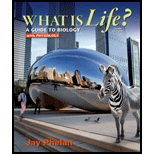
What is Life? A Guide to Biology with Physiology
3rd Edition
ISBN: 9781464157745
Author: Jay Phelan
Publisher: W. H. Freeman
expand_more
expand_more
format_list_bulleted
Question
Chapter 10, Problem 1SA
Summary Introduction
To review:
The groups of organisms currently living on earth that most resemble the earliest life forms.
Introduction:
The first life forms were primitive single cells, with genetic material and only an outer lipid membrane.
Expert Solution & Answer
Explanation of Solution
The first life forms were similar to today’s prokaryotes. They were prokaryotic cells, with macromolecules inside them, having no membrane bound structures. Fossils of such life forms have been found in Australia and South Africa.
Conclusion
The prokaryotes currently living on earth are most similar to the earliest life forms.
Want to see more full solutions like this?
Subscribe now to access step-by-step solutions to millions of textbook problems written by subject matter experts!
Students have asked these similar questions
Briefly state the physical meaning of the electrocapillary equation (Lippman equation).
Explain in a small summary how:
What genetic information can be obtained from a Punnet square? What genetic information cannot be determined from a Punnet square?
Why might a Punnet Square be beneficial to understanding genetics/inheritance?
In a small summary write down:
Chapter 10 Solutions
What is Life? A Guide to Biology with Physiology
Ch. 10 - Prob. 1SACh. 10 - Prob. 2SACh. 10 - Prob. 3SACh. 10 - Prob. 4SACh. 10 - Prob. 5SACh. 10 - Prob. 6SACh. 10 - Prob. 7SACh. 10 - Prob. 8SACh. 10 - Prob. 9SACh. 10 - Prob. 10SA
Ch. 10 - Prob. 11SACh. 10 - Prob. 12SACh. 10 - Prob. 13SACh. 10 - Prob. 14SACh. 10 - Prob. 15SACh. 10 - Prob. 16SACh. 10 - Prob. 17SACh. 10 - Prob. 1MCCh. 10 - Prob. 2MCCh. 10 - Prob. 3MCCh. 10 - Prob. 4MCCh. 10 - Prob. 5MCCh. 10 - Prob. 6MCCh. 10 - Prob. 7MCCh. 10 - Prob. 8MCCh. 10 - Prob. 9MCCh. 10 - Prob. 10MCCh. 10 - Prob. 11MCCh. 10 - Prob. 12MCCh. 10 - Prob. 13MCCh. 10 - Prob. 14MCCh. 10 - Prob. 15MCCh. 10 - Prob. 16MCCh. 10 - Prob. 17MC
Knowledge Booster
Learn more about
Need a deep-dive on the concept behind this application? Look no further. Learn more about this topic, biology and related others by exploring similar questions and additional content below.Similar questions
- Not part of a graded assignment, from a past midtermarrow_forwardNoggin mutation: The mouse, one of the phenotypic consequences of Noggin mutationis mispatterning of the spinal cord, in the posterior region of the mouse embryo, suchthat in the hindlimb region the more ventral fates are lost, and the dorsal Pax3 domain isexpanded. (this experiment is not in the lectures).a. Hypothesis for why: What would be your hypothesis for why the ventral fatesare lost and dorsal fates expanded? Include in your answer the words notochord,BMP, SHH and either (or both of) surface ectoderm or lateral plate mesodermarrow_forwardNot part of a graded assignment, from a past midtermarrow_forward
- Explain in a flowcharts organazing the words down below: genetics Chromosomes Inheritance DNA & Genes Mutations Proteinsarrow_forwardplease helparrow_forwardWhat does the heavy dark line along collecting duct tell us about water reabsorption in this individual at this time? What does the heavy dark line along collecting duct tell us about ADH secretion in this individual at this time?arrow_forward
arrow_back_ios
SEE MORE QUESTIONS
arrow_forward_ios
Recommended textbooks for you

 Biology: The Dynamic Science (MindTap Course List)BiologyISBN:9781305389892Author:Peter J. Russell, Paul E. Hertz, Beverly McMillanPublisher:Cengage Learning
Biology: The Dynamic Science (MindTap Course List)BiologyISBN:9781305389892Author:Peter J. Russell, Paul E. Hertz, Beverly McMillanPublisher:Cengage Learning Concepts of BiologyBiologyISBN:9781938168116Author:Samantha Fowler, Rebecca Roush, James WisePublisher:OpenStax College
Concepts of BiologyBiologyISBN:9781938168116Author:Samantha Fowler, Rebecca Roush, James WisePublisher:OpenStax College Biology (MindTap Course List)BiologyISBN:9781337392938Author:Eldra Solomon, Charles Martin, Diana W. Martin, Linda R. BergPublisher:Cengage Learning
Biology (MindTap Course List)BiologyISBN:9781337392938Author:Eldra Solomon, Charles Martin, Diana W. Martin, Linda R. BergPublisher:Cengage Learning Biology Today and Tomorrow without Physiology (Mi...BiologyISBN:9781305117396Author:Cecie Starr, Christine Evers, Lisa StarrPublisher:Cengage Learning
Biology Today and Tomorrow without Physiology (Mi...BiologyISBN:9781305117396Author:Cecie Starr, Christine Evers, Lisa StarrPublisher:Cengage Learning Human Biology (MindTap Course List)BiologyISBN:9781305112100Author:Cecie Starr, Beverly McMillanPublisher:Cengage Learning
Human Biology (MindTap Course List)BiologyISBN:9781305112100Author:Cecie Starr, Beverly McMillanPublisher:Cengage Learning


Biology: The Dynamic Science (MindTap Course List)
Biology
ISBN:9781305389892
Author:Peter J. Russell, Paul E. Hertz, Beverly McMillan
Publisher:Cengage Learning

Concepts of Biology
Biology
ISBN:9781938168116
Author:Samantha Fowler, Rebecca Roush, James Wise
Publisher:OpenStax College

Biology (MindTap Course List)
Biology
ISBN:9781337392938
Author:Eldra Solomon, Charles Martin, Diana W. Martin, Linda R. Berg
Publisher:Cengage Learning

Biology Today and Tomorrow without Physiology (Mi...
Biology
ISBN:9781305117396
Author:Cecie Starr, Christine Evers, Lisa Starr
Publisher:Cengage Learning

Human Biology (MindTap Course List)
Biology
ISBN:9781305112100
Author:Cecie Starr, Beverly McMillan
Publisher:Cengage Learning
Fossils & Evidence For Evolution | Evolution | Biology | FuseSchool; Author: FuseSchool - Global Education;https://www.youtube.com/watch?v=iYr3sYS9e0w;License: Standard YouTube License, CC-BY
Dig In To Paleontology; Author: SciShow Kids;https://www.youtube.com/watch?v=1FjyKmpmQzc;License: Standard YouTube License, CC-BY